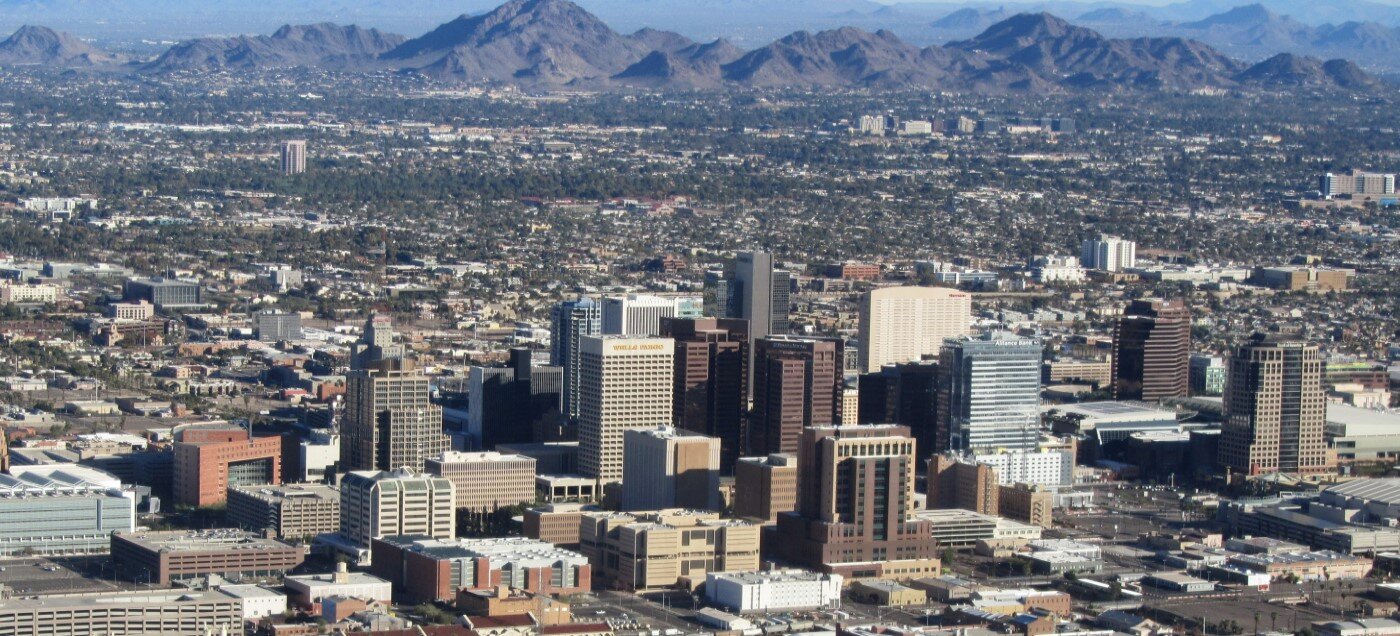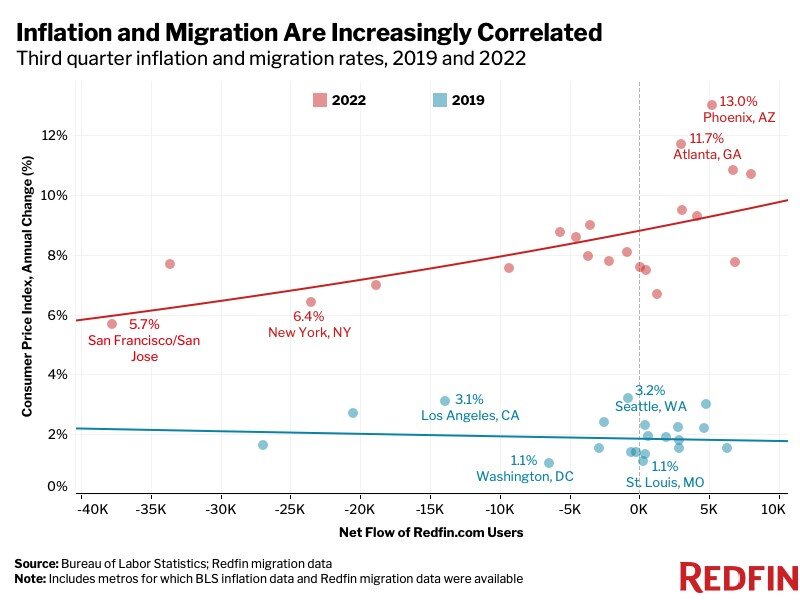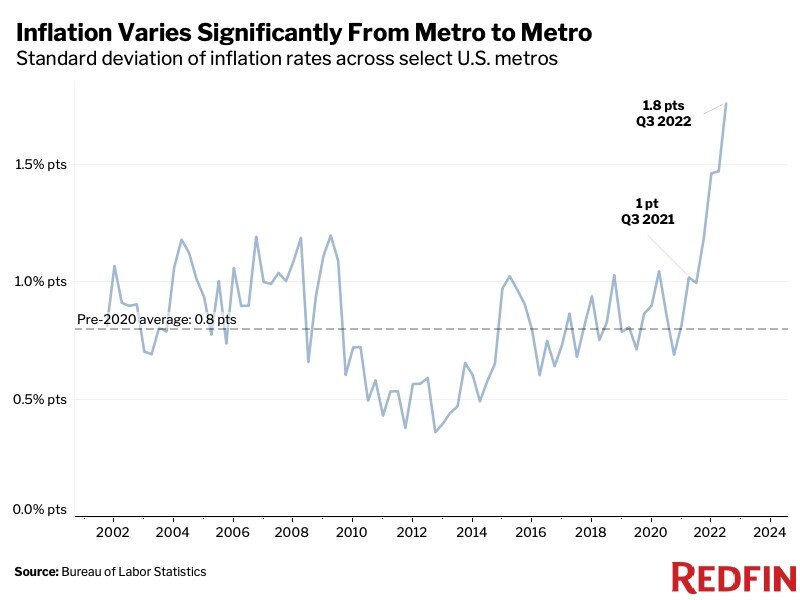Residential Real Estate News

Pandemic Boomtowns Like Phoenix, Miami Now Have Highest Inflation Rates in Q3
Residential News » Phoenix Edition | By David Barley | November 15, 2022 8:21 AM ET
According to Redfin, the four U.S. metropolitan areas with the highest inflation rates in the third quarter are Covid migration hotspots.
Phoenix, Atlanta, Tampa and Miami experienced double-digit inflation and all ranked near the top of Redfin's list of most popular destinations for relocating homebuyers.
In Phoenix, the price of goods and services rose 13% year over year on average, the highest inflation rate among the metros for which the U.S. Bureau of Labor Statistics (BLS) provides inflation data. Phoenix was the sixth-most popular destination for Redfin.com users looking to move from one metro to another in the third quarter.
Atlanta, the 15th most popular destination, had the second highest inflation rate, at 11.7%, and Tampa (10.9%) clocked in at number three for inflation and number five for migration. Miami had the fourth highest inflation rate (10.7%) and was the second most popular migration destination. Nationwide, the inflation rate was 8.3% in the third quarter.
The places homebuyers are leaving have the lowest inflation rates. Prices in San Francisco rose 5.7% in the third quarter, the lowest inflation rate among the metros Redfin analyzed and less than half the rate of Phoenix. The Bay Area was number one on the list of places Redfin.com users looked to leave in the third quarter. New York had the second-lowest inflation rate (6.4%) and was number three on the list of metros homebuyers looked to leave.
Inflation and migration have become increasingly linked. Remote work allowed scores of Americans to move to the Sun Belt during the pandemic in search of affordability and warm weather, which drove up housing prices, a key contributor to inflation. That's why migration hotspots now have the highest inflation rates--a trend that was much less acute before the pandemic. In 2019, for example, Los Angeles had the second highest inflation rate, but it was losing residents.
"The pandemic triggered a great rebalancing of affordability," said Redfin Deputy Chief Economist Taylor Marr. "Americans left pricey coastal job centers and moved to more affordable places in the Sun Belt, but now those more affordable places are seeing affordability erode faster than anywhere else in the country. Some of these areas may lose their titles as top migration destinations in 2023 as a result."
Popular migration destinations have also seen inflation accelerate relatively quickly. For example, Phoenix's inflation rate has more than quadrupled in the past three years, rising from 3% in the third quarter of 2019 to 13% in the third quarter of 2022. Meanwhile, San Francisco's inflation rate has roughly doubled, rising from 2.7% to 5.7%.
Housing costs are a bigger inflation driver in popular migration destinations
The increase in housing costs is a bigger contributor to inflation in migration hotspots than in the places homebuyers are leaving.
In Phoenix, for instance, shelter costs rose 19% year over year in August, one of the top inflation drivers. That compares with Phoenix's overall inflation rate of 13%. Food was also a major contributor to inflation, with prices up 14.1%.
By comparison, San Francisco only saw shelter costs increase 2.1% year over year, one of the smallest inflation drivers. Fuel, transportation and food were much bigger contributors to the region's overall inflation rate, which was 5.7%. Redfin plans to update these figures through October on Thursday, Nov. 10, when the BLS is scheduled to release its latest data.
Variance in inflation rates across the country is at a record high
The discrepancy in inflation rates across the U.S. is at the most extreme level on record because so many places surged in popularity during the pandemic while so many others plummeted in popularity.
The typical variability in the inflation rate among the metros Redfin analyzed in the third quarter was 1.8 percentage points, up from 1 percentage point a year earlier and a pre-2020 average of 0.8 percentage points.
Phoenix's 13% third-quarter inflation rate, the highest among the metros Redfin analyzed, was more than double San Francisco's 5.7% rate, which was the lowest among the metros Redfin analyzed. That's a gap of 7.3 percentage points. By comparison, there was only a 2.1-percentage-point gap between the highest and lowest inflation metros in the third quarter of 2019; Seattle had an inflation rate of 3.2%, while Washington, D.C. had an inflation rate of 1.1%.
Sign Up Free | The WPJ Weekly Newsletter
Relevant real estate news.
Actionable market intelligence.
Right to your inbox every week.
Real Estate Listings Showcase
Related News Stories
Residential Real Estate Headlines
- More Americans Opting for Renting Over Homeownership in 2024
- BLOCKTITLE Global Property Tokenization Platform Announced
- Small Investors Quietly Reshaping the U.S. Housing Market in Late 2024
- Greater Miami Overall Residential Sales Dip 9 Percent in November
- U.S. Home Sales Enjoy Largest Annual Increase in 3 Years Post Presidential Election
- U.S. Housing Industry Reacts to the Federal Reserve's Late 2024 Rate Cut
- U.S. Home Builders Express Optimism for 2025
- Older Americans More Likely to Buy Disaster-Prone Homes
- NAR's 10 Top U.S. Housing Markets for 2025 Revealed
- U.S. Mortgage Delinquencies Continue to Rise in September
- U.S. Mortgage Rates Tick Down in Early December
- Post Trump Election, U.S. Homebuyer Sentiment Hits 3-Year High in November
- Global Listings Aims to Become the Future 'Amazon of Real Estate' Shopping Platform
- Greater Las Vegas Home Sales Jump 15 Percent in November
- Ultra Luxury Home Sales Globally Experience Slowdown in Q3
- World Property Exchange Announces Development Plan
- Hong Kong Housing Market to Reach Equilibrium in Late 2025
- Construction Job Openings in U.S. Down 40 Percent Annually in October
- U.S. Mortgage Applications Increase in Late October
- World Property Markets, World Property Media to Commence Industry Joint-Venture Funding Rounds in 2025
- New Home Sales Hit 2 Year Low in America
- U.S. Pending Home Sales Increase for Third Consecutive Month in October
- Pandemic-led Residential Rent Boom is Now Fizzling in the U.S.
- Emerging Global Real Estate Streamer WPC TV Expands Video Programming Lineup
- 1 in 5 Renters in America Entire Paycheck Used to Pay Monthly Rent in 2024
- U.S. Home Sales Jump 3.4 Percent in October
- Home Buyers Negotiation Power Grows Amid Cooling U.S. Market
- Canadian Home Sales Surge in October, Reaching a Two-Year High
- Greater Orlando Area Home Sales Continue to Slide in October
- U.S. Mortgage Credit Availability Increased in October
- U.S. Mortgage Rates Remain Stubbornly High Post Election, Rate Cuts
- Construction Input Prices Continue to Rise in October
- BETTER MLS: A New Agent and Broker Owned National Listings Platform Announced
- Home Prices Rise in 87 Percent of U.S. Metros in Q3
- Caribbean Islands Enjoying a New Era of Luxury Property Developments
- The World's First 'Global Listings Service' Announced
- Agent Commission Rates Continue to Slip Post NAR Settlement
- Market Share of First Time Home Buyers Hit Historic Low in U.S.
- Greater Palm Beach Area Residential Sales Drop 20 Percent Annually in September
- Mortgage Applications in U.S. Dip in Late October







